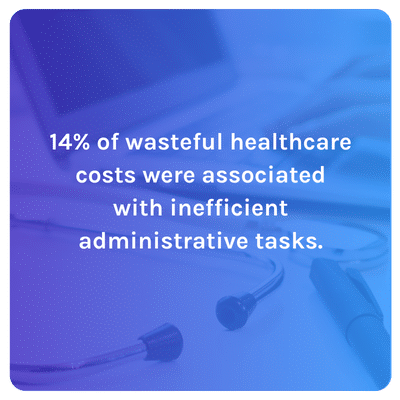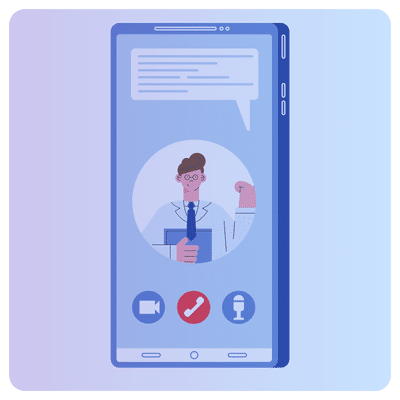What is conversational AI and how does it work?
Conversational AI allows machines to understand and respond to human language naturally. It uses natural language processing and machine learning to analyze input, generate responses, and simulate human-like conversations.
What are the implications in healthcare?
Healthcare has been going through a rapid digital transformation. Conversational AI stands at the forefront, redefining how we communicate, interact, and solve problems. This powerful technology has found its place in various industries, lucky for us In healthcare, it significantly improves patient communication.
From ASR to VA, the internet of acronyms that are driving innovation in care
From transcribing human speech and medical notes through Automatic Speech Recognition (ASR) to harnessing the power of Deep Learning (DL) for diagnostic accuracy, the landscape of healthcare is getting a tech makeover. Natural Language Processing (NLP), Natural Language Understanding (NLU), and Natural Language Generation (NLG) algorithms are making future interactions with patients more personal and insightful, improving response quality through input generation. With the ability to process and analyze unstructured data sets, conversational AI is transforming the way healthcare is delivered. Unfamiliar with how these different types of language models fit together? This video helps to explain:
In healthcare, we’re already seeing how these Machine Learning (ML) models are assisting in the optimization of treatment plans and predicting patient outcomes. Even Virtual Assistants (VAs) are stepping into roles for telehealth support and appointment scheduling, using input from training data to improve their performance. While they may be a mouthful, these AI-related acronyms are not just jargon; they’re gears in a much larger machine that’s setting the course for groundbreaking innovations in virtually every industry.
ChatGPT, Google, Siri, oh my! Imagining AI in healthcare
To appreciate the revolution that conversational AI solutions, or artificial intelligence, brings to the healthcare sector, let’s first look at what this technology looks like to providers and patients. Many people are already seeing chatbots, voice assistants, and messaging apps mimicking human conversation through generative AI.
Powered by machine learning and natural language processing, these systems use large volumes of data and recognize speech and text inputs, imitating human interactions and even translating their meanings across various languages.
In healthcare, the implications for AI technology is great as they have the potential to enable personalized experiences and drive increased value for patients in care relationships. We are already seeing tools like ChatGPT become cheaper to use and with that will come more accessibility from large health networks to small practices.
Across all industries, instant analysis of conversational data can provide us a detailed view of a customer’s history, wants, and needs. Not only that, these same tools leverage the insights to instantly produce efficiencies in communication, boosting customer satisfaction, with the ability to carry on conversation without human intervention.
Imagine receiving a suggested message for your patient’s question instantly? Reduction in the time to response alone could have a major impact on patient satisfaction scores.
Chatbots do not replace clinical knowledge
Healthcare is different from every other industry. The doctor/patient relationship that drives the best possible outcome is built through a human touch and deep clinical understanding.

Consider the future of conversational AI — not as a means to replace clinician knowledge and expertise, but to supplement it with insights and suggestions that can save time and create the best possible patient experience.
Beyond the bot: Benefits galore
So, what exactly does conversational AI bring to the table in healthcare? The answer lies in the various touch points of healthcare delivery. As a first step let’s consider the benefits.
Improve patient experience
One of the foremost benefits of conversational AI this conversational technology is its ability to improve patient engagement and deliver a better customer experience, or as its better recognized in healthcare, patient experience. In today’s healthcare paradigm, patient-centric care communication is not just a catchphrase; studies show it is a component of quality outcomes and also can help to build trusted relationships with providers. By utilizing conversational AI, healthcare providers can enhance the overall user experience for patients, making interactions more immersive and engaging. This not only improves patient satisfaction but also has the potential to improve customer engagement and the overall quality of care.
Boost patient engagement
Conversational AI, with its ability to offer instant responses and personalized interactions, can enhance patient engagement, making the patient an active participant in their healthcare journey. Participating goes a long way in achieving higher customer interactions, engagement, and satisfaction.
Increase practice efficiency
Another notable benefit is the assistance in streamlining workflows. Many tools can automate routine tasks such as scheduling appointments, answering frequently asked questions, and managing patient records.
Save money
Moreover, this technology can help reduce operational costs significantly. One study found that 14% of wasteful US healthcare costs were from inefficient administrative tasks. By taking on tedious or repetitive tasks, these intelligence tools are allowing healthcare providers to focus on what they do best: providing care.

Improving efficiency also reduces cost by allowing providers and staff to spend less time on tasks that could be automated, giving them bandwidth to intake more patients and complete the more complex work.
Automate tasks
Additionally, the implementation of chatbots, such as a conversational AI platform, can automate a significant portion of customer service conversations, saving time for both businesses and customers. This not only decreases wait times but also allows businesses to allocate their resources towards addressing more complex customer support, or in this case, patient support issues. With the ability to understand customer queries, provide relevant information, and guide towards solutions, conversational AI has become increasingly important in recent years in automating tasks and improving the efficiency of customer service teams in the healthcare industry.
In essence, whether it’s enhancing patient communication, improving operational efficiency, or reducing costs, conversational AI is becoming a game-changer in the healthcare industry.
Peering into the future

As we look towards the future, the applications in healthcare are set to expand exponentially. From diagnostics and treatment planning to patient monitoring and follow-up care, the possibilities are endless.
One of the most exciting future applications is in diagnostics. AI has the potential to play a significant role in treatment planning, offering personalized recommendations based on a patient’s unique health profile.
Imagine having the ability to marry data from the patient’s health record with all of the information shared over the course of all your two-way patient conversations?
AI-enhanced insights will give you the information you need to guide conversation with speed and accuracy. They could even deliver suggested, editable responses to patient inquiries saving you time and ensuring an empathetic approach to your communication.
Conversational AI: Automation and scalability to improve patient conversations
Healthcare is continually seeing innovations and technological advancements, and conversational AI stands out for its unique advantages and patient-centric approach.
Traditional healthcare communication methods often involve long wait times, potential miscommunication, and limited availability. In contrast, conversational AI can offer an instant, accurate, always-on approach to communication. Anchored in natural language processing, AI tools can now understand the nuances of human language and can provide personalized responses to user queries and answer questions making patients feel heard and valued. Additionally, conversational AI can overcome challenges posed by slang, unscripted language, dialects, and even sarcasm, ensuring efficient processing of input.
Moreover, conversational AI is data-driven. It learns from past interactions to improve future conversations, making it a valuable tool for data collection and storage of customer information. Partnered with the internal knowledge of your organization’s staff, leveraging conversational AI can help to facilitate a high-value care experience. It’s like having a virtual assistant next to you summarizing patient details and prompting you with ways you can respond, similar to conversing with a human agent. This way, you are always in control of the conversation, customer data, and how you use the AI.
How effective is an AI response in care settings?
As you think through the different scenarios where this type of AI assistance might be helpful, you might be asking yourself, how effective is an AI response, really?
The Journal of the American Medical Association found that patients rated AI responses as more empathetic, and of higher quality than actual physician responses. This doesn’t mean that AI should replace the clinical knowledge of your staff. It can support you though.
It is intelligent enough to draft thoughtful, empathetic responses to your patient. You make the call on reviewing, editing and sending.
Think of all the use cases where this type of support can save time and foster a better relationship with each patient.

The Pros and Cons of Conversational AI: A Balanced Perspective
Conversational AI in healthcare has both upsides and downsides. Understanding these benefits and challenges is key to harnessing the power of this technology to its fullest extent. Let’s delve into the specifics.
The Pros
As we noted in the benefits section, when correctly implemented, the power of conversational AI to simplify and smoothen doctor/patient communication is unmatched.
Pairing patient health data with these conversations has the potential to vastly improve the experience, cutting down on oversight and potential contradictory communication.
As we’ve said before, AI should never replace the expertise of the clinician. AI can, however, enhance the clinician’s ability to deliver the best possible experience and outcome for the patient by providing contextual information, automation for time savings, and pathways to stronger connections.
There is a world in the very near future where AI can suggest responses and even tweaks to a providers language to make patient outreach feel more empathetic, compassionate, and personalized.
Couple an AI-enabled patient communication platform with a bidirectional EHR integration, and you give yourself the ability to instantly tailor the conversation experience to, not only the patient’s preferences, but also to better support their health goals.
The cons
While conversational AI transforms healthcare, challenges exist. Data security issues, miscommunication, and losing the human touch in patient interactions are key concerns to address.
For data security, choose a HIPAA-compliant platform that protects patient privacy and sensitive information. Conversational AI is designed to work alongside providers, supplementing their clinical knowledge with added patient insight and context and saving valuable time. HIPAA compliance is a two way street. Ensure both the vendor you choose to work with is built to adhere to HIPAA privacy rules, and that you have security measures in place at your practice. This includes continual training opportunities for your staff.
Best practices for maintaining accuracy and human interactions include always viewing conversational AI as a supplemental technology to your clinical intelligence. AI can work like a supportive coach, aiding providers in delivering care that is not just clinically sound but also emotionally supportive.
Steps toward more efficient conversations
The journey towards a more conversational healthcare system has its hurdles, but the destination — a more efficient, patient-centric healthcare ecosystem — makes it a journey worth taking.
Solutions like OhMD are already making strides toward this more efficient future.
We know that, from scheduling appointments to managing the never-ending intake of patient information, routine tasks take up valuable time that could be better spent on patient care. Automation of these tasks could be done with a mix of tools, such as marrying conversational AI and telecommunications that allows patients to start an automated SMS conversation flow just by texting a keyword, reducing the need for time-consuming phone calls.
There is so much more on the way that we can’t wait to show you. From suggesting responses to contextual summaries of patient conversations that will save your team hours of time, a smarter conversation engine stands to change the way providers and patients communicate.
A More Human Future
What is the ultimate goal of conversational AI in healthcare? It is, without a doubt, to create a more human-centric healthcare system.
In this new healthcare paradigm, patients are not just recipients of care, but active participants. The patients are engaged, informed, and empowered. They are not just understood in terms of symptoms and diseases, but as individuals with unique needs and preferences.
And healthcare providers? They’re not just caregivers, but conversationalists. They’re not just treating diseases, but connecting with patients. Harnessing the power of technology not to replace human connection, but to enhance it.
As we harness the power of conversational AI, we are not just improving healthcare delivery. We are redefining it. We are creating a healthcare system that’s not just about healing, but about connecting. A system where care is not just given, but shared. A system that’s not just efficient, but human.
Because at the end of the day, that’s what healthcare is all about. It’s about people. It’s about conversations. And with conversational AI, we’re making these conversations count.
So, let’s embrace the change. Let’s make healthcare more conversational. Let’s make it more human.




